Welcome as the Cosmere Cuisine tour arrives once again on Roshar, the setting of Brandon Sanderson’s ambitious epic Stormlight Archive. Roshar is a land of highstorms, glowing stormlight, shattered plains, and trees called “drop-deads.”
Throughout the series, readers are rewarded with a plethora of details and descriptions about the land, the various cultures, and—most importantly to me—the foods. The cuisine in Alethkar are not the same as in Thaylen or Herdaz. This article will focus on foods from the rest of Roshar, outside of the Vorin Kingdoms and their curries. If you missed Part 1 and its dive into Vorin cuisine, you can find it here.
Warning: In discussing the Roshar ecology and meals, there are small spoilers from all the published Stormlight Archive books. Skip ahead to the recipes, if you have not read Oathbringer.
As I wrote in Part 1, Roshar’s foods are hard to translate into Earth foods, except in the case of Shinovar. We have not spent much time in Shinovar, however, or seen Szeth’s culture at this point in time. (Fingers crossed for book 5 and his flashbacks.) We know they have the most Earth-like climate, and familiar plants and animals. One could get a beef steak there, for example, while on the rest of Roshar, you will be left asking “Where’s the beef?”
Having covered a general outline of the animals and plants used for food on Roshar, it is time to dive deeper into drinks before discussing the recipes from these other lands. What do they drink on Roshar? Thankfully for me as a tea lover, that’s one beverage that is definitely available. Nothing has indicated that Roshar’s tea selection is limited to one type—only that it seems to be served warm— so feel free to indulge in your black, green, white, herbal, or fruit-based teas. There is also Rock’s chilled drink from cremling shells—I have not developed a recipe for that, but its existence does indicate ice is readily available to use in drinks.
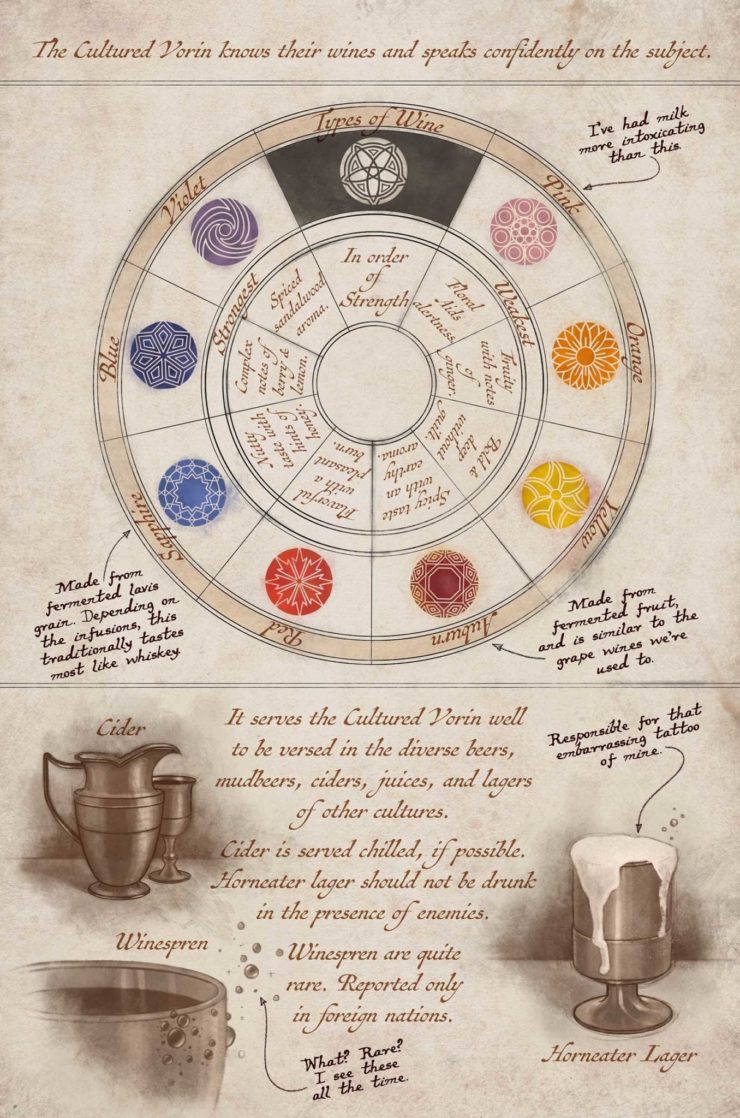
One worldbuilding element that has inspired many fan discussions is the “wine” chart published in Oathbringer. While many fans find calling all alcoholic drinks “wine” funny, in some ways Americans are just as limited in our thoughts about drinks as Rosharans. Western cultures tend to think of wine as a grape-based item. Sanderson has said repeatedly there are no grapes on Roshar. Yet, even on Earth, wine can be made from any fruit juice, along with a few other products. The juice simply needs the right amount of sugars, yeasts, and the proper conditions to kick start the fermentation process. On Earth we make wine from a host of foods, including lychees, pineapples, peaches, agave, and more. Distilling creates more potent alcoholic spirits, such as brandies and harder liquors.
The same principle applies to the grains on Roshar: lavis (corn), tallew (rice), clema (buckwheat), treb (cassava root), and Shin wheat (Earth grains with gluten). Fermenting these grains can produce a mild beer or a strong moonshine-style liquor when distilled. It just depends on how the ingredients are processed. Most fans have heard of sake, however there are a multitude of other rice drinks, both alcoholic and otherwise. Rice beer is well known in Asia and is a larger component of beer than non-brewers might be aware of. Tallew is a major grain across Roshar, and it’s likely that people will use the available produce creatively, just as we have here on Earth.
I’ve heard many fans compare Horneater White to some form of moonshine, yet there are other possible equivalents besides a grain alcohol. In the Philippines there is a coconut liquor called lambanog that is highly potent—if not distilled properly, it can be toxic, causing serious damage. If Shallan is drinking that stuff by the bottle, I’m glad she has stormlight for healing. There are many palm wines made to similar proof levels, several translating roughly into “white wine.”
Like Veil, we learned in Oathbringer that the color-coding system for “wines” is based on an artificial product, with infusions of various types used to generate the colors. So rather than looking at the color of your product, if you want to create a flight of Rosharan drinks, look at the color system as a ABV (alcohol by volume) ranking that includes plain juices. If you must have some blue wine, though, there are Earth companies willing to accommodate you.
Maybe worldhoppers from Nalthis are comfortable on Roshar because they can find familiar-tasting juice blends and seafood dishes. Roshar is large, encompassing a number of cultures. The local drink of choice will change, just as the local food of choice will change from place to place. After spending time in the Vorin food traditions during Part 1, it is time to explore some of the other food traditions we are exposed to through the some of the books’ beloved characters…
Herdaz and Chouta
A small land north of Jah Keved and Alethkar, Herdaz is not a Vorin Kingdom. Herdazians do not follow the sweet/spicy divide of Vorin food tradition. Their food is considered flavorful, but not spicy on Roshar. Based on their location and available resources, they are going to use primarily gluten-free grains like their southern neighbors. Herdazians have spread across Roshar to create culture clusters inside the various other countries and have almost certainly adopted local food items into their diets. The Herdazian food traditions are not based upon traditional Mexican food/flavors, despite the partial cultural inspiration Sanderson used in creating their culture. It would have been easier for me to simply pull from Tex-Mex flavors, but that wouldn’t be true to the text.
Yes, The Lopen is offended: I made fans wait until now for a chouta recipe and only one type is presented below. We know there are many types, in the warcamps and across Roshar. When I first read about the street food, I envisioned a falafel wrap with a brown gravy. Then I thought about a chimichanga with meatballs. Research led in a different direction from either of those items.
Chouta is described as a meatball made with “undefinable” fried meat, covered in gravy, wrapped in a thick bread. Lopin says lavis (corn) is used in both the meatball and the bread. It’s flavorful, but not too spicy. This is an example of a food description that is evocative, but not actually helpful in creating a recipe.
The first chouta we saw in the series used flangria meat, made from soulcasting. This leads to the question of what it tastes like… In a recent Livestream, Sanderson made several comments about the soulcast meat, implying that it’s an “acquired taste.” He said that some vegetarians might interpret it as fine to eat, since it was never part of a living animal. Kalyani Poluri, who helped with the curries, says that as a strict vegetarian raised in India, she would not eat soulcast meat. So while I’m always happy when Sanderson answers food-related questions, this still leaves much to the imagination about what flangria actually tastes like.
In this recipe, I chose to use an even blend of pork and turkey meats in the chouta balls to create a possible Rosharan flavor profile beyond chicken. As we learned in Oathbringer, there are different kinds of chouta, including ones using cremling claws. Thus, if you want to use a meat substitute, then call it chouta, I don’t think a Herdazian would argue with you—just make it taste good and they will want some too.
I took some liberties in plating my chouta and with my toppings. Lopen would probably have a few jokes to make about the flatbread I used. It is not as thick as a chouta wrap should be because I used store-bought cassava flour tortillas. Wrapping them twice like a street taco is just fine, in my opinion. If you want to make your own cassava flour tortillas, please give them a try. Or try one of the hundreds of other types of flatbreads that are possible on Earth or Roshar. Of course, stuffing the chouta balls in like a pita or a burrito makes them easy to handle one-handed, but more difficult to photograph.
* * *
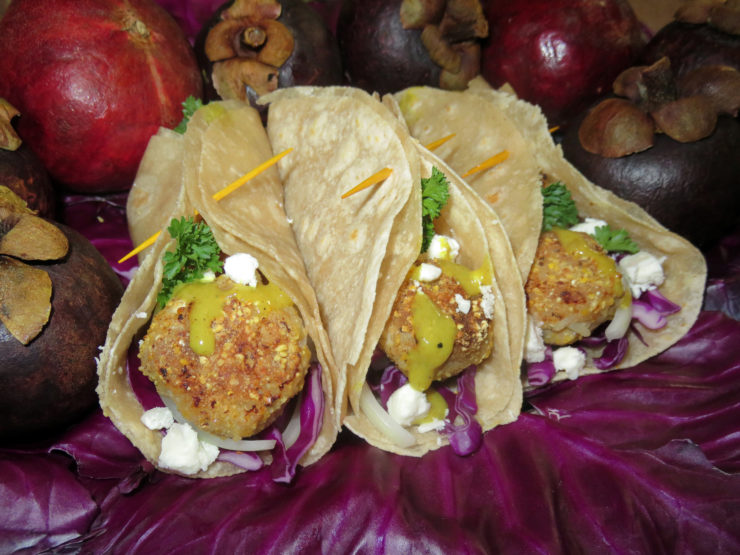
Chouta
This chouta is inspired by tefteli, Russian meatballs with rice. I pulled from Russia, because it is on the Asian continent, but has a different food tradition than the other cultures discussed. This sauce is cream-based; the added curry and turmeric brighten its color considerably from the brown sauce Kaladin mentions. A chouta is similar to a stuffed pita sandwich, so include whatever appeals to your taste buds when filling one.
Ingredients
For the Meatballs:
- 1 pound ground meat, anything but beef (I used 1/2 pound of pork and turkey)
- 1 cup cooked rice – cooled to room temperature
- 1 large egg
- 1 small onion, grated (not just diced)
- 2-3 garlic cloves, diced
- 1 tablespoon horseradish (to taste and potency, use less if made fresh)
- 1/2 teaspoon kosher salt
- 1/4 teaspoon coriander
- 1/4 teaspoon crushed red pepper
- 1/4 teaspoon black pepper
- 1/3 cup cassava flour for dredging
- 4 tablespoons cornmeal
- 2+ tablespoons oil
For the Sauce:
- 2 tablespoons butter
- 2 tablespoons flour (I used cassava)
- 2 cups broth (I used chicken)
- 1/4 cup sour cream
- ¼ to 1/2 teaspoon crushed red pepper (to taste)
- ¼ teaspoon curry powder
- ¼ teaspoon turmeric
- ¼ teaspoon coriander
- ½ teaspoon kosher salt
- ⅛ teaspoon black pepper
For the Wrap:
- Flatbread (I used cassava flour tortillas)
- Feta Cheese
- Onions
- Red cabbage
- Hummus
Directions
Chouta meatballs:
- Cook the rice ahead of time. I like to use chicken stock as half the cooking liquid for more flavor. Let it cool to room temperature or chill in the refrigerator.
- In a small bowl mix 2 tablespoons of cornmeal and flour for dredging, set aside.
- Finely grate the onion. This improves the texture of the meatball
- In a large bowl, mix ground meat, rice, egg, grated onion, garlic, horseradish, remaining 2 tablespoons of cornmeal, and all spices together.
- Roll the mixture into balls about 1” to 1 ¼” thick. Dredge in the flour-cornmeal mixture. Place on a pan lined with wax or parchment paper.
- Heat a skillet over medium heat, add 2 tablespoons of oil. Cook the meatballs in batches. Let cook on one side for 4 minutes, then flip to cook the other side 3-4 minutes. Should be golden brown. The cornmeal flakes will really stand out. Add more oil as needed to finish cooking the batches.
- Transfer to a paper towel lined plate to rest.
Sauce:
- Make a roux: in the same skillet, after excess oil is removed, melt butter then whisk in the flour until it’s a golden color. Add the broth, whisking often until it starts to thicken.
- Add the sour cream, let simmer for a minute. Add sauce spices, whisking them in well. Watch the color change. Adjust salt, red, and black pepper amounts to your taste. Thicken until it clings to the back of a spoon.
- Optional: If you like saucy meatballs, add the chouta back to the pan and let simmer in the sauce for 2-4 minutes. This allows more time for the flavors to blend.
Alternately, if you want to keep the crisp texture on the chouta’s exterior, drizzle the sauce on them after plated/stuffed (as shown in photo).
Wrap:
- Take flatbread of choice, heat it on a pan with butter or oil. Toast both sides.
- Add vegetables of choice or even more rice. Shown are hummus, red cabbage, and sliced onions.
- Add chouta balls, top with sauce and other garnish as you wish. Serve warm.
The Horneater Peaks and Stew
The Horneater Peaks are a mountain range that creates a natural land barrier between Jah Kaved and Alethkar. Despite being between these Vorin Kingdoms, the Unkalaki people do not practice Vorinism as a culture. Sanderson has said Rock’s people are an inspired mashup of Hawaiian, Scottish, and Russian cultures. Physically, due to Singer blood in their ancestry, they have extra jaw pieces that allow them to eat the shells which cover most native Rosharan animals.
The Horneaters know how important food is to the world: They declare first and second sons must cook! They are also the only culture which developed descriptive words for the birds on their mountains. Earth geese are common there and are not called chickens! Due to the micro-climates the warmth from their mountaintop lakes generate, crops grow around the peaks at higher altitudes than is typically possible on Roshar.
Overall, the Unkalaki use fewer spices in their dishes than the Alethi, yet their food is far from bland. In fact, Rock really loves spicy peppers. The love Bridge 4 shows for his stews demonstrates how flavorful his cuisine can be. Another important element in these dishes is texture. Numuhukumakiaki’aialunamor, aka Rock, will ask “Where’s the crunch?” While he can get crunch from cremling shells, he also enjoys adding it via his favorite vegetable, radishes. The Horneater Peaks are probably filled with a variety of radishes due to their ability to thrive in poor soil conditions. I personally envision him hoisting a three-foot long daikon radish on his shoulder.
Despite the Horneaters’ cultural inspiration, the food tradition for Rock’s stews comes more from the Korean soups haemultang and maeuntang. These are spicy seafood soups Sanderson was exposed to while living in South Korea. However, he probably ate very little of them given his known aversion to seafood. These soups share a dashi stock base, then build in flavor from a stone soup-like tradition. Add to the pot whatever you have that will taste good to you.
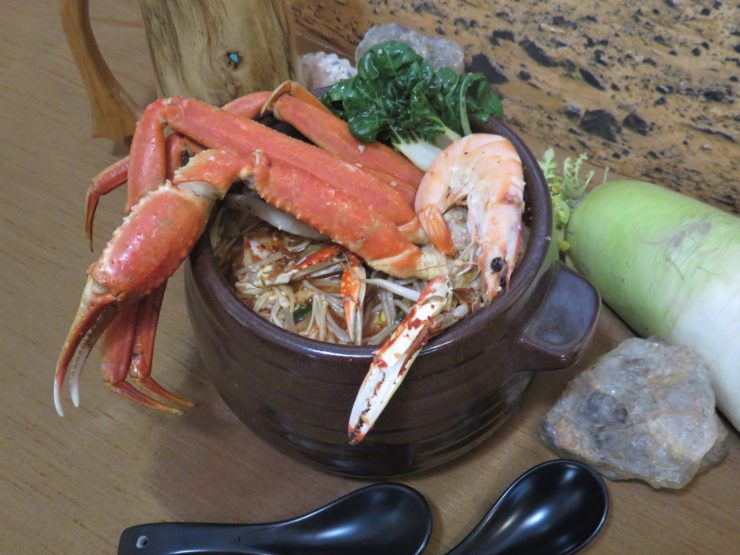
Rock’s Stew
Bridge 4 had a different “Rock stew” each night, so all any one recipe can capture is a single instance. For more inspiration, look up recipes for haemultang and maeuntang. Just be sure to include some spice and a crunchy bite to honor Rock and the Horneaters. The enoki mushrooms in this particular stew reminded me of plants from Shallan’s sketchbooks of the lait found on the way to the Shattered Plains.
This recipe uses soba noodles, a clema (buckwheat)-based pasta common on the Asian continent. Rice or other fillers are fine when you need to expand the soups beyond seafood-based ingredients. If you cannot find the listed seafood at your local market, substitute in what you can find and afford. I chose crab and shrimp as the cremlings that I like to eat. Same with the vegetables—mix in what you can find and enjoy eating. To really explore possibilities, walk around a local Asian market to pick up fresh vegetables. If you want your vegetables to provide the crunchy bites, keep some reserved, adding them in shortly before serving the soup.
Ingredients
- 6 – 8 cups of water
- 6-8 large dried anchovies OR dashi pouch OR dashi power
- 2 cups daikon radish, julienned
- 1 bundle of soba noodles
- 1 large crab leg cluster
- ¼ pound shrimp, deveined (head on or off, mostly off for me)
- ¼ pound of small soft-shell crab OR 8 oz crab cocktail fingers
- 7 oz of tofu, drained and cubed
- 4-6 baby bok choy, quartered
- 3 green onions, sliced
- 3 oz mung bean sprouts
- 2.5 oz enoki mushrooms
Seasoning paste:
- 8 garlic cloves, finely chopped
- 1 – 2 tablespoons gochujang (use more for spicier results)
- 1 tablespoon doenjang
- 1 tablespoon soy sauce
- 1 tablespoon fish sauce
- 1 tablespoon mirin
- 1 teaspoon ginger, grated
- ½ teaspoon kosher salt
- ⅛ teaspoon black pepper
- ⅛ teaspoon crushed red pepper
Directions
- Wash and chop your vegetables. Wash and clean your proteins.
- Make or buy your dashi. For this recipe, to make your base, add 4 cups of water, the cleaned and gutted anchovies and half the radishes to a very large pot. Alternately, add the pouch OR powder with the radish to 4 cups of water. Let boil for 20 minutes. Removed the whole anchovies or pouch after the boil period.
- Meanwhile, make the seasoning paste by combining all spices and sauces together in a small bowl. Set aside.
- Boil the soba noodles. I prefer to boil the soba noodles in their own pot, then add them to the soup pot towards the end of the process. (Adding noodles makes it more Horneater, and less of a traditional Korean dish.)
- To the stock pot, add 2 more cups of water and half the seasoning paste. Mix well. Let boil for 2 minutes.
- Add the tofu and the vegetables to the pot. Mix well, turn heat down, let simmer for 4 minutes.
- Add the crab legs and soft-shell crab. Add more water if needed. Simmer for a few minutes.
- Taste, add more seasoning paste to your spice level.
- Add shrimp, cooked soba noodles, and remaining vegetables set aside for crunch to the pot. Let simmer until the shrimp are bright pink and cooked.
- Serve from the pot, giving everyone large bowls. Share the large crab leg cluster.
- If everyone at the party likes crab, buy more large clusters, boil separately in a pot with a portion of seasoning paste in the water.
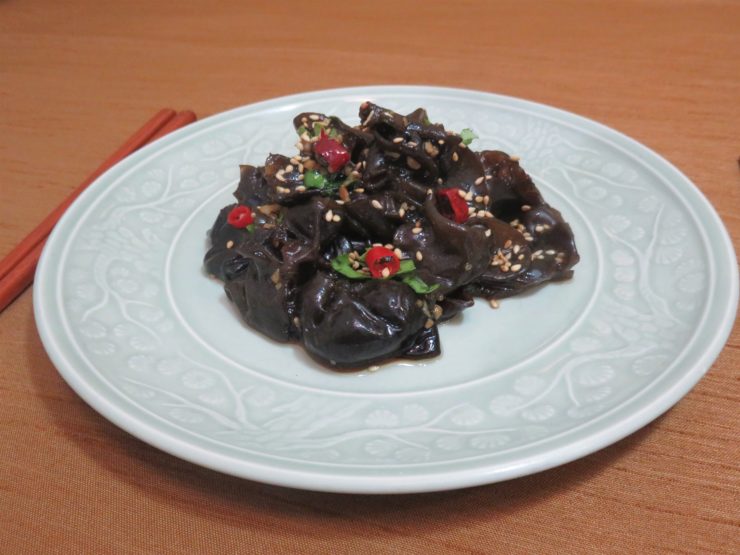
Wood Ear Mushrooms Salad
Since the peaks are surrounded by forests, mushrooms are a safe bet in the Unkalaki diet. This side dish is based on a Chinese recipe typically served chilled. If you cannot find, or do not like, wood ear mushrooms, try the sauce on a different type of mushroom. The texture of the cooked wood ears is rather like calamari. The sesame seed garnish adds the crunch.
Ingredients
- 2 cups fresh mushrooms OR 1/2 to 1 cup dried mushrooms, must rehydrate
- 2 cloves garlic, grated
- 1 Thai chili pepper, chopped & deseeded (fresh or dried, use with caution, optional)
- 1/4 cup cilantro, chopped
- 1 tablespoon soy sauce
- 1 teaspoon rice vinegar
- 1/2 teaspoon sugar
- 1/8 teaspoon kosher salt
- 1 tablespoon vegetable oil
- 1 teaspoon whole peppercorns
Directions
- Wash and trim the mushrooms properly. Re-hydrate as needed for dried mushrooms (you will need more water).
- Bring a pot of water to a boil. Add wood ear mushrooms and cook for 3 minutes. Drain, rinse the mushrooms with cold water, drain again, and set aside.
- Combine cilantro, garlic, chili pepper (if using), soy sauce, rice vinegar, sugar, and salt in a small bowl. Stir to mix well.
- Heat oil in a small skillet until warm, add whole peppercorns. Cook until you can smell a strong fragrance, 2 to 3 minutes. Stop heat. Remove the peppercorns with a slotted spoon. (If you really like biting into a peppercorn, leave them.)
- Pour the hot oil into the sauce mixture. Stir well.
- Combine the sauce and mushrooms in a bowl, toss a few times to coat well.
- Transfer to a serving dish, garnish with sesame seeds, more cilantro, or more pepper slices.
Tashikk and Azir
The southwestern lands on Roshar loosely create the Makabak region, dominated by the Azish Empire. These lands are loosely connected, but we have not spent much time there thus far in The Stormlight Archive. The one exception is when Lift visits Yeddaw, the main city in Tashikk. Tashikk is a country of large flat grasslands, focused on lavis (corn) and tallew (rice) production. They are also a hub for information exchange with a vast network of spanreeds. Yet Sanderson has provided very few hints about their culture base or food traditions.
During the Weeping the city celebrates the new year by eating ten types of pancakes—nine of which they have recipes for; the tenth is a spiritual one dedicated to Tashi. Lift was highly upset at that. She would be enthusiastic about the large variety of pancake styles here on Earth. The issue for Earth cooks trying to recreate Yeddaw’s pancake types is trying to figure out what Sanderson intended with his descriptions. Despite Lift being food-focused, her thoughts about the pancakes are rather lacking in details. For example, Sanderson only explains six of them in the story:
From Edgedancer:
- Full of vegetables
- Salty, with chopped-up vegetables.
- Sweet.
- Fluffier than others, almost without any substance to it, with sauce.
- Dense with mashed-up paste in the center that was too sticky and salty.
- Covered in little crunchy seeds.
We then have a bit more information, from a Word of Brandon:
- Seafood-filled.
- Undecided, probably a very savory spicy one.
- Undecided, probably something with spinach in it and more like a fritter.
- Dedicated to Tahsi and is a thought exercise.
I’m imaging #6 is a buckwheat and chia seed pancake. The “fluffier” #4 must use baking powder, where the others might not. Due to Tashikk’s proximity to Shiniovar, trade of perishable food items including grains is more likely. It is possible that some of these pancake recipes use wheat flour. Yet when developing your versions try to use other flours or blends, like tallew (rice) and lavis (corn) as signature products of Tashikk. Sweet potatoes are common on Roshar, so try incorporating them into a latke- or fritter-inspired pancake.
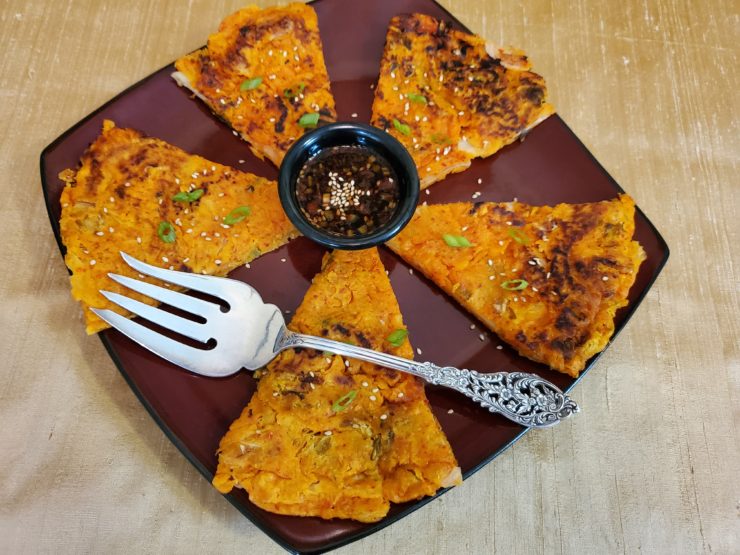
Weeping Pancake: Kimchijeon
For now, I’m only going to focus on the “full of vegetables” pancake. That description could apply to multiple pancakes styles. Staying with the theme of dishes inspired by Asian traditions, I’m using kimchijeon as the base recipe. If you are not familiar with them, they are Koren pancakes made using kimchi, batter, and often served as one large item cut into smaller pieces. This recipe is the Rosharan version, so I made it using millet and coconut flours (these are typically made with wheat flour). Millet is one of the oldest grains known on earth and fits with the general trend of the grains discussed in Part 1.
The kimchi provides a bright orange color to the pancake. Kimchi comes in a range of flavors, from extremely spicy to sweet. Lift doesn’t mention a spicy taste, so my personal preference for the mild to sweet types seems appropriate. They are commonly served with a sauce—though, since Lift stole her first one, she missed out on any sauces.
Ingredients
- 1 cup thinly sliced fully-fermented kimchi (I used sweet store-bought)
- 1 to 2 scallions
- 1/4 medium onion, sliced
- ½ cup millet flour
- ½ cup coconut flour
- OR use 1 cup regular flour, skipping the two flours above
- 1/4 cup corn starch (sweet rice flour an option too)
- 1/4 cup liquid from kimchi (use more water if unavailable)
- 1 tablespoon gochujang (to taste)
- 1 lightly beaten egg
- ⅛ teaspoon baking powder (skip if using wheat flour)
- 1 cup icy cold water
- Oil to cook
- Chopped green onion and sesame seeds for garnish
Dipping Sauce:
- 1 tablespoon soy sauce
- 1 teaspoon rice vinegar
- 1 tablespoon water
- 1/4 teaspoon sesame oil
- 1/2 teaspoon sugar
- ½ teaspoon minced garlic
- ⅛ teaspoon black pepper
- ¼ teaspoon of chili flakes (to taste, optional)
Directions
Pancake
- In a large bowl add the kimchi liquid and gochujang, whisk together. Set aside to dissolve while preparing the other ingredients.
- Thinly slice the kimchi and onions. Cut the scallions into about 2-inch pieces. If the white part is thick, cut in half lengthwise.
- Combine the flours; I like to shift them. Then add baking powder and cornstarch. Stir together gently.
- Whisk an egg into kimchi liquid and gochujang mixture. Then add to the flour mixture. Add ½ cup of cold water to batter. Stir. Add up to another ½ cup of water to create a thick batter that will flow off a spoon.
- Fold in the kimchi, scallions, and onions
- Heat one tablespoon of oil in a non-stick pan over medium heat.
- Ladle the mixture into the pan, and spread it evenly into a thin round shape, sized to your choice. Cook until the edges turn light brown, about 3 minutes.
- Turn it over, and add more oil to the sides of the pan. Gently swirl the pan to distribute the oil under the pancakes.
- Press the pancake down with a spatula if it bubbles up. Cook until the other side is nicely browned and crispy, 2 to 3 minutes.
- Repeat the process until there is no remaining batter. Keep adding oil as needed to the pan to help the frying process.
- Serve hot with the dipping sauce. Garnish with sesame seeds, more kimchi, or scallions. Wyndle shardfork optional.
Dipping Sauce:
(Can be made ahead of time, stored in airtight container.)
- Mince garlic.
- Combine all ingredients, whisk well. Make sure the sugar dissolves.
- Let rest at least 5 minutes for flavors to blend.
Sweet Ending
Desserts on Roshar have not been discussed much in the books. In Azir, we know they have berry cakes. With the Vorin food divide, they might signal the end of their meals by partaking of a spice blend such as mukhwas. Other places could do fruit and cheese platters, or simply not have a traditional end-of-meal dish. Many cultures on Earth do not have an end of meal “dessert,” but do have sweet treats. Since I’m from Oklahoma, I feel compelled to end our Rosharan food tour on a sweet note.
With rice being universally accessible, I am confident in saying rice pudding would be a familiar dish across Roshar. While black rice is a treat in my thinking, it could be common for our characters. The strange thing about this recipe is that while I don’t like coconut, I like this pudding. Something about the deep color, the cinnamon and sugar, it tricks my brain into tasting a form of chocolate. (No promises that will happen for you.)

Black Rice Coconut Pudding
Ingredients
- 2 -2 ½ cups water
- 1 cup black rice
- 1 cup coconut milk
- 1 cinnamon stick OR 1 teaspoon ground cinnamon
- 3 tablespoons brown sugar
- ½ teaspoon salt
- Toasted coconut flakes for garnish
Directions
- Measure out, then rinse your black rice twice in a strainer under cool water.
- In a saucepan, mix water, coconut milk, and rice. Bring to a boil over medium-high heat for 2 minutes.
- Reduce heat and simmer uncovered for 20 minutes. Stir occasionally.
- Add cinnamon around the 20 minute mark. Mix in well, keep stirring occasionally for another 10 minutes.
- At the 30 minute mark add the sugar and salt. Start watching the rice more, stirring frequently. Add more water up to ½ cup a little bit at a time to prevent the rice from getting too dry.
- Taste, add extra sugar if desired, or extra coconut milk to create a looser pudding. Remove the cinnamon stick, if used.
- Serve warm, garnish with coconut flakes.
The rice pudding is not very sweet by American dessert standards, but I hope you find it a satisfying end to our wide-ranging food tour. Now you can go forth and create yummy Rosharan food based on my recipes or of your own imagination. Rock, The Lopen, and I want to know about your creations and suggestions… Meanwhile, we wait for Rhythm of War to be released—let’s plan our meals for the release parties, be they private affairs or a gathering of friends!
Deana Whitney is a foodie, researcher, and a Sanderson beta reader. The Rosharan menus were the largest challenge of the Cosmere Cuisine series. They took much longer to develop than she intended. Reading Rhythm of War, and everyone’s reactions to it, will be a highlight of 2020.










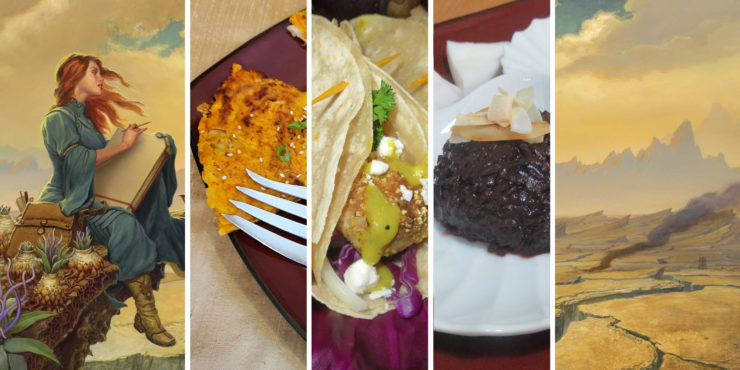
I hope you are getting the credit you deserve for this series :) This is some next level stuff!
Suddenly the world of Roshar is coming to life so much more with these food in the flesh, so to speak!
The chouta looks a lot like what I had in my head, but swap out the tortillas for a thin pit like a gyro uses.
Very cool post!
Is mirim distinct from mirin, or is there a typo in the Rock’s stew recipe?
How fun! I have a somewhat similar take on Chouta that I have been making for my family for a couple years now. Are you ever going to do food from other places, such as scadrial? Because I have always wanted to try making baywraps.
Thanks for all the comments! I hope you all enjoy the food!!!
@5, gaussian – thanks for the heads up on the “mirin”, yes it was a simple typo. Fixed now.
@6, Kieran Grant – Yes, I’ve now done all the worlds we have a full book for. check them out at https://www.tor.com/tag/cosmere-cuisine/
Scadrial was among the first one. I hope you like the take on baywraps.
Storm it. I read this while eating dinner, and it still made me hungry. And the COVID-19 pandemic has limited my access to sources of such highly diverse groceries.
Beef may not be found outside Shinovar, but I believe a number of characters have been described as “beefy.” That’s ostensibly a result of Alethi-to-English translation where “porky” would have conveyed the wrong meaning. (In the US at least, a “beefy” person is robust or muscular and a “porky” person is fat or fleshy.)
“Cuisine” is misspelled in the title. Not trying to be critical, just trying to be helpful on a site I read every day.
@9 – Fixed, thank you!
yum! I love this series and I’m glad it’s still going
Mmmm – those choutas (and the pancakes) look soo good (although I also would have pictured something more pita look).
Huge NOPE to Rock’s stew though. I don’t do shellfish, lol. Especially not when I can see the shells!
Don’t you mean…Parshmen paper? heh. heheh.
Thank you so much for bringing my fantasies to life!